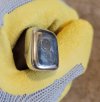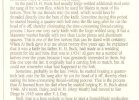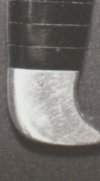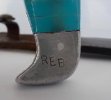Generalist
Gold Member
- Joined
- May 10, 2025
- Messages
- 191
This is a rambling manufacturing/construction question for those familiar with pre-1961 Bucks. The below is my understanding and may be incomplete or inaccurate. Please add/correct if you can. I feel fairly uneducated in this area.
Pommels
Some 1940s fixed blades (and maybe earlier?) had pommel rivets. I presume those indicate pinned construction? From 1951-1963 Buck switched to/between threaded pommels and barrel nuts and seems to have switched which more than once (around '55 and in '61?).
Blades
Until 1961 blades were used files, which were hard from being previously heat treated, and therefore probably difficult to drill for pinned construction. The early 1960s forged blades were similarly pre-hardened? This seems to explain why brazing a bolt to the tang might have been easier than drilling for a pinned connection. However, for some period, tangs were actually threaded (prior to bolt brazing). That seems more difficult than drilling a hole for a pinned connection?
The main question(s)
Were the earliest Buck knives truly pinned construction, and if so, was the switch to and from threaded tangs/bolts for ease of manufacturing using pre hardened blade material? Or were other factors driving all the changes in blade/handle connections from the '40s-'60s?
Pommels
Some 1940s fixed blades (and maybe earlier?) had pommel rivets. I presume those indicate pinned construction? From 1951-1963 Buck switched to/between threaded pommels and barrel nuts and seems to have switched which more than once (around '55 and in '61?).
Blades
Until 1961 blades were used files, which were hard from being previously heat treated, and therefore probably difficult to drill for pinned construction. The early 1960s forged blades were similarly pre-hardened? This seems to explain why brazing a bolt to the tang might have been easier than drilling for a pinned connection. However, for some period, tangs were actually threaded (prior to bolt brazing). That seems more difficult than drilling a hole for a pinned connection?
The main question(s)
Were the earliest Buck knives truly pinned construction, and if so, was the switch to and from threaded tangs/bolts for ease of manufacturing using pre hardened blade material? Or were other factors driving all the changes in blade/handle connections from the '40s-'60s?
















